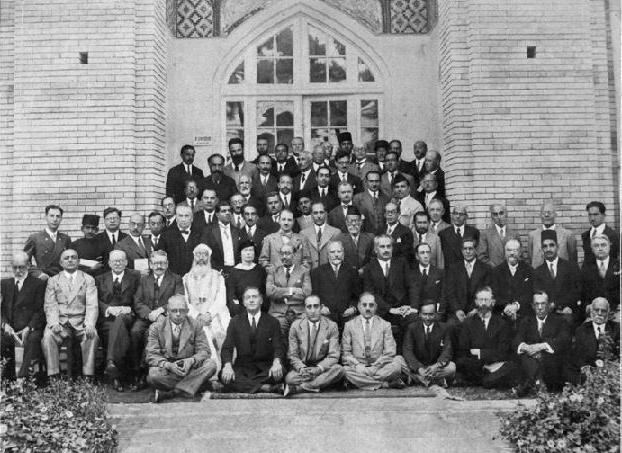 | ||
The Ferdowsi Millenary Celebration (Persian: جشن هزاره فردوسی) was a series of celebrations and scholarly events in the year 1934 to commemorate the thousandth anniversary of Ferdowsi's birth. The Ferdowsi Millenary was announced at the beginning of the year by the government of Iran. The Millenary Congress convened for five days from 2 to 6 October 1934 in Tehran, and more than eighty notable European and Iranian scholars attended the congress. The celebrations lasted for nearly a month.
Contents
- Participants in the Millenary Congress
- Scholarly publications related to the Millenary
- Impact of the Ferdowsi Millenary on Iranian Studies
- References
Simultaneously various official ceremonies were held in a number of European countries including France, Britain, Germany and the Soviet Union, in universities, clubs, and embassies. Also, a number of other countries including United States, Egypt and Iraq held festivities.
Participants in the Millenary Congress
The gathering of some one hundred distinguished scholars as well as many dignitaries of various nationalities in Tehran and Mashad was a most beneficial event for Iranian studies in general and for research on Ferdowsi and the Shahnameh in particular.
Distinguished participants included: Henri Massé (France), Vladimir Minorsky (England), Sebastian Beck (Germany), Evgeniĭ Berthels (Soviet Union), Georges Contenau (France), Arthur Christensen (Denmark), Friedrich Sarre (Germany), Denison Ross (England), A. A. Bolotnikof (Soviet Union), Jan Rypka (Czechoslovakia), Franklin Gunther (United States), Alexsandr Freiman (Soviet Union), Yuri N. Marr (Soviet Union), Aleksandr A. Romaskevich (Soviet Union), Iosef Orbeli (Soviet Union), Jamshedji Unvala (India), Bahramgor Anklesaria (India), Antonio Pagliaro (Italy), Ernst Kühnel (Germany), L. A. Mayer (Palestine), John Drinkwater (England), Syed Abdul Kareem Hussaini (Hyderabad-Deccan, India).
The Persian delegation, with forty members, was led by Mohammad-Ali Foroughi (who delivered the inaugural speech) and included among others: Mohammad-Taqi Bahar, Ali-Asgar Hekmat, Ahmad Bahmanyar, Abbas Eqbal, Badiozzaman Forouzanfar, Ahmad Kasravi, Mojtaba Minovi, Said Nafisi, Hassan Pirnia, and Ebrahim Pourdavoud.
The final event of the celebrations was the inauguration of the new building for the mausoleum of Ferdowsi in Tous, by the congress participants, with the presence of Reza Shah Pahlavi.
Scholarly publications related to the Millenary
An important outcome of the Ferdowsi millenary was the publication of a large number of scholarly works dedicated to the study of Ferdowsi and the Shahnameh, notably:
Impact of the Ferdowsi Millenary on Iranian Studies
Several participants of the congress expressed the opinion that the greatest service that the scholarly world could render to the Persian-speaking people would be the publication of a critical and reliable edition of the Shahnameh. The Borūḵīm Publishing House in Tehran tried to address this issue and published the complete text of the Šāh-nāma, based on Vullers edition under the supervision of Mojtaba Minovi, Abbas Eqbal, Solayman Haïm and Said Nafisi.
Fritz Wolff, made a lasting contribution with the publication of his glossary of Ferdowsi's Shahnameh (Glossar zu Ferdosis Schahname), which was presented as a gift to the Persian people by the German ambassador in the first day of the congress.
These contributions greatly advanced the Iranian scholarship, and led to the appearance of a number of monumental scholarly works on Ferdowsi and Shahnameh in the later decades.
